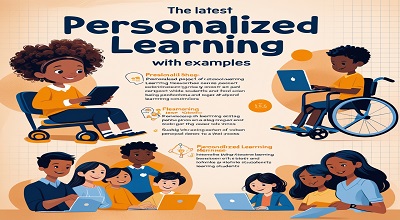Personalized Learning Trends
Personalized Learning Trends: Personalized learning is an educational approach that tailors instruction to meet the individual needs, skills, and interests of each student. Unlike traditional one-size-fits-all teaching methods, personalized learning leverages technology, data, and flexible teaching strategies to create a more engaging and effective learning experience.
With advancements in EdTech, schools and institutions are increasingly adopting personalised learning models to improve student outcomes. This article explores the latest trends, real-world examples, and future directions of personalized learning.
Why Personalized Learning Matters?
Personalized learning has gained traction due to its numerous benefits:
- Improved Student Engagement – Lessons tailored to students’ interests increase motivation.
- Better Learning Outcomes – Students progress at their own pace, mastering concepts before moving forward.
- Inclusivity – Supports diverse learning styles and special needs.
- Efficient Use of Technology – AI and adaptive tools provide real-time feedback.
- Prepares Students for the Future – Develops critical thinking and self-directed learning skills.
Latest Personalized Learning Trends
1. Adaptive Learning Technologies
Adaptive learning platforms use algorithms to adjust content based on student performance. Examples:
- DreamBox (Math) – Adapts problems in real-time.
- Smart Sparrow – Customizable learning experiences.
2. AI and Machine Learning in Education
AI-powered tutors like Squirrel AI and Carnegie Learning provide personalized recommendations and automate grading.
3. Competency-Based Education (CBE)
Students advance upon mastering skills, not just time spent in class. Example: Western Governors University.
4. Learning Analytics and Data-Driven Instruction
Tools like Google Classroom and PowerSchool track student progress to inform teaching strategies.
5. Gamification and Personalized Learning
Platforms like Classcraft and Prodigy Math use game mechanics to tailor learning experiences.
6. Microlearning and Bite-Sized Content
Short, focused lessons (e.g., Duolingo, Khan Academy) improve retention.
7. Personalized Learning Pathways
Students choose their learning journey. Example: Summit Learning.
8. Social-Emotional Learning (SEL) Integration
Tools like Nearpod and Peekapak combine academics with emotional growth.
9. Blended and Hybrid Learning Models
Combines online and in-person learning (e.g., Flipped Classroom).
10. Voice Assistants and Smart Tutors
AI assistants like Amazon Alexa for Education support personalized queries.
Examples of Personalized Learning in Action
- AltSchool – Uses tech to customize curricula.
- Knewton Alta – Adaptive courseware for higher ed.
- Newsela – Adjusts reading levels for students.
Challenges and Solutions in Personalized Learning
| Challenge | Solution |
|---|---|
| Data Privacy Concerns | Use secure, compliant platforms (e.g., GDPR, FERPA). |
| Teacher Training | Professional development in EdTech tools. |
| Equity and Access | Provide devices and internet for underserved students. |
Future of Personalized Learning
- More AI integration (predictive analytics, chatbots).
- VR/AR for immersive learning.
- Blockchain for credentialing.
Conclusion
Personalized learning is transforming education by making it more student-centered. As technology evolves, its impact will grow, ensuring every learner gets the support they need.
FAQs
1. What is personalized learning?
Personalized learning tailors education to individual student needs using technology and data.
2. How does AI support personalized learning?
AI analyzes student performance to recommend customized content and automate feedback.
3. What are the best tools for personalized learning?
Examples include DreamBox, Khan Academy, and Nearpod.
4. Is personalized learning effective?
Yes, studies show improved engagement and academic performance.
5. What are the challenges of personalized learning?
Key challenges include data privacy, teacher training, and ensuring equitable access.
Free Here: Legends Of Elementia APK
